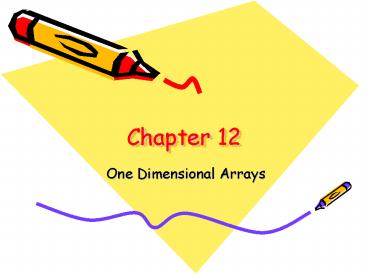One Dimensional Arrays - PowerPoint PPT Presentation
1 / 19
Title:
One Dimensional Arrays
Description:
3) Show code to print all the numbers in the array. for (int i=0; i SIZE; i ) ... bool flags[8]; char grades[100] int scores[10] Type of cells # of memory ... – PowerPoint PPT presentation
Number of Views:21
Avg rating:3.0/5.0
Title: One Dimensional Arrays
1
Chapter 12
- One Dimensional Arrays
2
C Data Types
3
Structured Data Types
- Struct
- Class
- Union
- array
4
Structured Data Typearray
- Array linearly-ordered collection of
homogeneous data elements (collection of elements
of the same type) - Linearly-ordered there is a first, second,
third, etc. element
5
Array Properties
- All elements in the array are of the same type.
- Elements are accessed by their index, starting at
0 - Size of the array is fixed (cannot be increased
or decreased once an array has been created)
6
Why use arrays?
- Gives use the ability to store a large number of
elements using one variable name. - Examples
- Suppose we want to store 3 test grades int t1,
t2, t3 - How could we store 100 test grades?
7
Using C array
- Declare the array
- Initialize the array
- Access the array
- Passing an array as an argument
8
How to declare an array
- Examples
- int numbers10//stores 10 integers
- float averages30 //stores 30 floats
- --------------------------------------------
- //Better to use const
- const int CLASS_SIZE 25
- string namesCLASS_SIZE
9
You may want to initialize an array
- You can use a loop
- int numbers10
- for (int i0 ilt10 i)
- numbersi0
- 2) string names5 Sam, Joe, Carol,
Bill, Jane
10
How to Access array elements
- Must use an index (subscript)
- Index starts with 0
- Examples
- cout ltlt numbers4 ltlt endl
- //prints the 5th element in the array
11
How to access array elements (continued)
- int grades10
- cout ltltEnter 10 test grades\n
- for (int i0 ilt10 i)
- cin gtgtgradesi
12
Array Assignments
- Examples
- grades5 89
- grades5 grades4
- --------------------------------------------
- int a3
- int b3
- ab //illegal
13
Questions!
- Assume that we have an array of integers called
numbers of size, SIZE. - Show code to declare the array
- int numbersSIZE
- Show code to initialize the array to 0s.
- for (int i0 iltSIZE i)
- numbersi0
14
QUESTIONS
- 3) Show code to print all the numbers in the
array - for (int i0 iltSIZE i)
- cout ltltnumbersi ltlt endl
- 4) Show code to print the 5th number in the array
- cout ltltnumber4 ltlt endl
15
QUESTIONS
- How many memory cells are reserved for data and
what type of data can be stored there?
16
BE CAREFULL!
- C does not check for out-of-bounds array
indexes. For example, suppose - float alpha100
- The valid range of alpha is 0 through 99.
- Assume
- alphai62.4
- This is out-of-bounds if i is less than 0 or i is
greater than 99!
17
Passing an array as a parameter
- Assume
- const int TOTAL 10
- float finalGrade
- int gradesTOTAL
- Function prototype
- float average(int , int)
- Function call
- finalGrade average(grades, TOTAL)
- Function heading
- float average (int numbers, int size)
18
Array Notes
- Arrays are always passed by reference!
- The address of the beginning of the array is
passed as an argument to the function
19
HomeworkQuiz Grade
- Write a function called Smallest() which
receives as arguments an integer array called A
and an integer called Count where A has been
given values and Count is the total number of
integers found in the array. The function should
return the smallest integer found in the array.































